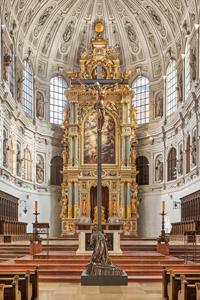In March of 2016, the new cross was installed in its central location before the altar. There it stood for over 200 years until 1819. Now, once again, it stands between the sacrifices of the Old and New Covenants depicted over the side altars. The ship of our church has a clear central axis, running from the child Pantocrator beneath the rear gallery to the Lord at his second coming atop the high alter. The axis directs us through the life and suffering of Jesus, who leads us through the cross into his glory.
The Crucifixion by the Flemish-Italian artist Jean de Boulogne, known as Giambologna, lends the church interior a dynamic focal point. Giambologna patterned the unique bronze sculpture according to the aesthetic ideals of the Renaissance. While the hands and feet are nailed to the cross, the body is displayed without injury, unblemished in its beauty. This makes visible to believers an inner reality: from the paradox of the Martyred One comes the love of God that transforms all things. This corpus anticipates the meaning of “the resurrection of the body.” It testifies to the way in which, at each Eucharist, the Risen One gathers his own members together in the meal. The community celebrates the presence of their Lord. He guides them into unity, strengthens their faith, and bestows upon them a future of life beyond death. At the foot of the cross kneels Mary Magdalene. Sculpted by Giambologna’s German master-student, she represents the believing soul in need of salvation. Her imploring, grief-stricken gaze seeks out the face of Jesus. Christian faith lives from such an intimate, heartfelt bond with Christ. The Spiritual Exercises of St. Ignatius direct one nowhere else. The architecture of St. Michaels, as with all the artwork in our Church, is thoroughly animated by this spirit.Until 1819 the cross - standing on the outer wall of the right transept today - was placed on the steps of the choir. In the crypt under the cross the founders of St. Michael, Duke William V and his wife Renata of Lorraine, had their final resting place. The corpus of the cross was moulded in 1594 by Giovanni da Bologna, the figure of Mary Magdalene by his student Hans Reichle.


